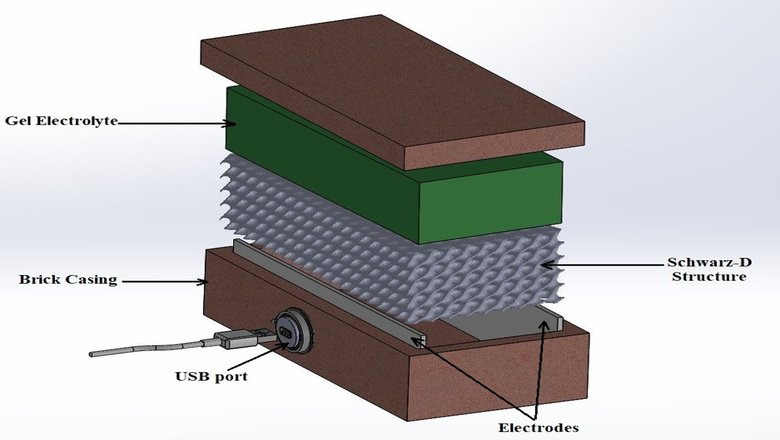 Bricks have been in use as building materials for millennia, but they can do so much more when science and technology are applied. A group of scientists led by King’s College London have developed a thermogalvanic brick that can generate electricity, as long as the two faces of the brick are at different temperatures. This is because of a balanced electrochemical reduction and oxidation processes occurring inside the brick at the two faces. As long as there is a temperature difference between the two faces – if, for example, the outside of a brick structure is hot and sunny but the inside is cool and shaded – the electrochemical reactions will occur and generate electricity. The compounds inside are not consumed, do not run out and cannot be overcharged.
Bricks have been in use as building materials for millennia, but they can do so much more when science and technology are applied. A group of scientists led by King’s College London have developed a thermogalvanic brick that can generate electricity, as long as the two faces of the brick are at different temperatures. This is because of a balanced electrochemical reduction and oxidation processes occurring inside the brick at the two faces. As long as there is a temperature difference between the two faces – if, for example, the outside of a brick structure is hot and sunny but the inside is cool and shaded – the electrochemical reactions will occur and generate electricity. The compounds inside are not consumed, do not run out and cannot be overcharged.
The researchers used gelled water inside the brick and added a 3D printed interior based upon a Schwarz D minimum surface structure. This makes the thermogalvanic bricks stronger than typical bricks, as well as allowing the electrochemical reactions to occur and improving insulation.
The scientists believe that these bricks could be used to provide both shelter and electricity in regions of the world that have limited access to both. The energy the bricks provide is both affordable and sustainable, and the bricks can easily be constructed.
“The idea is that these bricks could be 3D printed from recycled plastic, and be used to quickly and easily make something like a refugee shelter,” said Dr. Leigh Aldous, Senior Lecturer in the Department of Chemistry at King’s College. “By the simple act of keeping the occupants warmer or cooler than their surroundings, electricity will be produced, enough to provide some night time lighting, and recharge a mobile phone. Crucially, they do not require maintenance, recharging or refilling. Unlike batteries, they store no energy themselves, which also removes risk of fire and transport restrictions.”
 3D printing is being talked about as a promising way to quickly and sustainably build houses and other structures in areas that need them, but many of those areas also have limited resources in terms of electricity. 3D printing has been used in conjunction with alternative energy technologies in these areas before, such as solar power. The thermogalvanic bricks are something new, though, and the team, which also includes scientists from Arizona State University and the University of New South Wales Sydney, has filed a provisional patent for the bricks.
3D printing is being talked about as a promising way to quickly and sustainably build houses and other structures in areas that need them, but many of those areas also have limited resources in terms of electricity. 3D printing has been used in conjunction with alternative energy technologies in these areas before, such as solar power. The thermogalvanic bricks are something new, though, and the team, which also includes scientists from Arizona State University and the University of New South Wales Sydney, has filed a provisional patent for the bricks.
“What is so interesting is that we can take something so common and never thought about, such as temperature difference in houses, and use it to create electricity,” said King’s College undergraduate student Conor Beale. “For a family living in a developing country, this could have a substantial impact.”
Electricity is something that most people in the developed world take for granted, but without it, life, education and work are limited by the rising and setting of the sun. Having access to electricity could significantly impact productivity in locations that previously did not have access, not to mention allowing people to access technology like cell phones, computers – and maybe 3D printers.
Discuss this and other 3D printing topics at 3DPrintBoard.com or share your thoughts below.
Subscribe to Our Email Newsletter
Stay up-to-date on all the latest news from the 3D printing industry and receive information and offers from third party vendors.
You May Also Like
Air Force Awards Fortius Metals $1.25M to Qualify 3D Printing Wire for Hypersonic Applications
AFWERX, part of the US Air Force Research Laboratory (AFRL), awarded a Direct-to-Phase II Small Business Innovation Research (SBIR) contract worth $1.25 million to Colorado’s Fortius Metals, to accelerate qualification...
US Air Force Awards JuggerBot $4M for Large-format Hybrid 3D Printing
Large-format 3D printer manufacturer JuggerBot has received a $4 million grant to develop a large format 3D printer, courtesy of the Under Secretary of Defense, Research and Engineering Manufacturing Technology...
Where Have All AM’s Unicorns Gone?
In the rapidly evolving world of 3D printing, startups valued at over a billion dollars, known as unicorns, once seemed as fantastical as the mythical creatures themselves. While a few...
How My Childhood Fascination with Planes Led to Investing in 3D Printing
My fascination with aerospace started young, and I started studying planes–identifying them in the sky and learning everything I could about how they work. Fast forward to my first week...
































